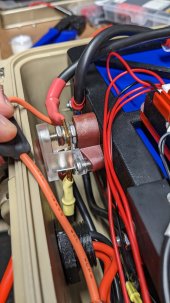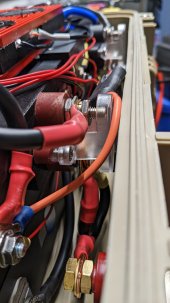buckeyestargazer
New Member
I just completed a battery build with EVE LF230 cells and have a question about the heat one of the components is generating.
Description:
EVE LF230 cells, Daly 100A BMS
The cells are in series connected with the tinned copper busbars that came with the batteries
I have a 60A in-line fuse from the main Pos terminal to a 150A buss bar.
The BMS Neg is connected to a corresponding 150A buss bar.
Connected to the buss bars are 1/4" terminal studs, a 50A Powerpole connector, and two 30A Powerpole connectors.
I used 6AWG wire throughout, except the two 30A Powerpole connectors have 12AWG silicon wire, fused.
As a test, I connected a Krieger 1100W inverter and connected a space heater to it. (I had no idea those space heaters pulled so much power!) I turned the space heater on low and the BMS reports it is pulling about 52A or 670W at 12.9v.
Now I have two questions.
1. The positive buss bar got REALLY hot to the touch. It would burn skin. The positive wires (from the battery pos terminal to the 60A fuse and from the fuse to the buss bar) are also uncomfortably hot. All of the other wires in the system are cool or only slightly warm. The negative buss bar is quite warm but nowhere near as warm as the positive. Is this normal? Should I replace the 6AWG main wires with 4AWG?
2. The BMS reports the voltage at 12.9v under load. The voltage at the bus bars is 12.4v, but the voltage at the terminal studs is only 11.9v. Also, the voltage at the inverter is only reading 11.4v. The inverter wires are 4AWG with a 150A fuse. I'm just surprised that the voltage at the terminal studs has dropped a full volt despite using very short runs of 6AWG wire. Again, is this something to be concerned about?
Thanks in advance.
Description:
EVE LF230 cells, Daly 100A BMS
The cells are in series connected with the tinned copper busbars that came with the batteries
I have a 60A in-line fuse from the main Pos terminal to a 150A buss bar.
The BMS Neg is connected to a corresponding 150A buss bar.
Connected to the buss bars are 1/4" terminal studs, a 50A Powerpole connector, and two 30A Powerpole connectors.
I used 6AWG wire throughout, except the two 30A Powerpole connectors have 12AWG silicon wire, fused.
As a test, I connected a Krieger 1100W inverter and connected a space heater to it. (I had no idea those space heaters pulled so much power!) I turned the space heater on low and the BMS reports it is pulling about 52A or 670W at 12.9v.
Now I have two questions.
1. The positive buss bar got REALLY hot to the touch. It would burn skin. The positive wires (from the battery pos terminal to the 60A fuse and from the fuse to the buss bar) are also uncomfortably hot. All of the other wires in the system are cool or only slightly warm. The negative buss bar is quite warm but nowhere near as warm as the positive. Is this normal? Should I replace the 6AWG main wires with 4AWG?
2. The BMS reports the voltage at 12.9v under load. The voltage at the bus bars is 12.4v, but the voltage at the terminal studs is only 11.9v. Also, the voltage at the inverter is only reading 11.4v. The inverter wires are 4AWG with a 150A fuse. I'm just surprised that the voltage at the terminal studs has dropped a full volt despite using very short runs of 6AWG wire. Again, is this something to be concerned about?
Thanks in advance.








